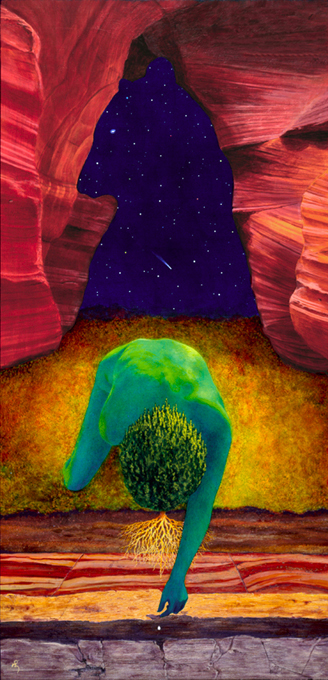
Attention to the instincts seems to have initiated a process that the unconscious equates to the planting of a seed. It first introduced the idea in a dream: Small white seeds are arriving in my mouth. Should I eat them or let them out? They have a paradoxical nature—they are the seeds of the seedless watermelon. They are arriving from visuddha, the throat chakra. I envision the seeds coming out of my mouth by their own power.
The paradoxical seed (the seed of the seedless watermelon) of the dream points to the nature of the Self or wholeness. The Self is a union of opposites, the seen and the unseen. The Self is the lapis or philosopher's stone of the alchemists. The stone is a symbol of the beginning and of the goal of the alchemical opus. The stone was said to be hidden in blackness, the prima materia. The blackness is everything you do not know about yourself and also different aspects of the psyche that are not yet expressed. It is sown into the black earth (prima materia) like a seed and will grow from it. It has the most paradoxical qualities; it is both divine and demonic. The seed comes from visuddha. In The Psychology of Kundalini Yoga, Jung tells us that the chakras can be thought of as centers of consciousness and that they can represent the developmental phases of consciousness. He characterizes visuddha as the center where the unseen becomes a reality. The dream seems to symbolize the beginning of the manifestation of the Self into reality.
The Sower plants the seed on bedrock. Bedrock would be synonymous with the archetypes, which form the bedrock of the psyche. So you could say that our wholeness must be grounded in the archetypal nature of existence. The figure plants the seed and her consciousness, her head, becomes a rooting tree that grows from this action (see detail). The tree is a symbol of a person's spiritual development. It has its roots in the earth and its branches extend to the heavens, just as our spiritual development should span the territory from the instincts to the spirit. Like the archetype, it must reach from the highest to the lowest and encompass the entire spectrum from the spiritual to the instinctual. The tree is also a symbol of Sophia as knowledge and wisdom. The upper rocks in the painting represent the slot canyons of the American southwest. A slot canyon is very deep and narrow. It is formed by runoff from nearby mountains. In my imagination it is a place that is like a cave but open to the sky. The cave represents the spiritual place within where we connect with our wholeness. In the cave we are initiated into the mysteries. To be initiated in a slot canyon might mean to be initiated in a more conscious condition (you are not completely underground), a condition where you are aware of the paradoxical nature of the Self.
The figure bends very low, so low that her head touches the earth, a gesture of the humility necessary to accept the very lowest in yourself. She is green. The alchemists tell us that during the initial stages of the work comes the "blessed greenness". You connect with the hidden world which is like experiencing a hidden springtime. They say that God breathed into created things a certain germination or greenness by which all things should multiply. To be green means to be able to grow. In Aurora Consurgens, von Franz tells us that the soul was thought to be a tincturing spirit that gives the body a garment or color. Also the soul itself was thought to be a colored garment that enveloped the material world.
She sows the seed of the hoped-for inner union of the opposites under the auspices of the bear, whose shape forms the opening of the cave. As I mentioned when writing about Light of the Earth, the bear is our most ancient symbol of the feminine. The bear is also the spirit that connects the past and the present, giving new expression to essential things from the past that must be carried forward. This aspect can be seen in the symbolism of King Arthur and the Grail legend. The name Arthur means bear-man. Like the bear, Arthur is a protector and preserver. He tried to connect and carry forward the essential aspects of Celtic wisdom (Brid) into Christianity with the idea of the Grail. The Grail is symbolic of this feminine Sophia/Brid energy. To bring the bear into the process is to bring the necessary instincts into the picture, the part of ourselves that Christianity excludes. If the instinct is left to itself it becomes nonhuman. If it is made to serve the ends of human love and cultural development, it is a force of great value. The bear is also our ferocity, our ability to stand true to what we are fighting for.
In the painting the bear is also the cosmos and in that glimpse of the cosmos is a comet. Scientists think that comets might have been the source of Earth's water and in effect seeded it for life. The sower seems to mirror the action above her and repeats the action in the cosmos on a human scale. She plants the life-giving seed of her future self.






